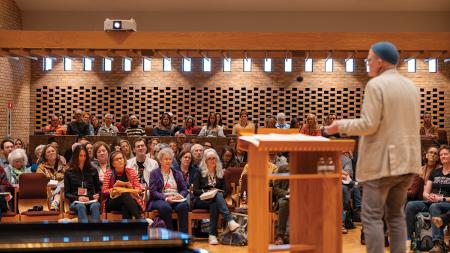Storm Doesn’t Dampen Spirits at Cadet International Camporee

Sunday worship at the 17th Cadet International Camporee.
Robert deJonge
Not long after the 17th Cadet International Camporee opened in Central Alberta late last month, the skies opened with heavy rain and strong winds swept Kamp Lone Pine, where more than 1,200 men and boys had set up their tents for the week.
Located near the town of Red Deer, the camp was soon awash with water and battered by the wind. But plans had already been in place should the weather turn bad.
“The campers were taken out of camp and brought to a couple local indoor recreation centers for swimming and games while the food staff that usually just distributes food, cooked meals for everyone,” says Robert deJonge, promotions chairman for the camporee.
“The campers ended up spending the night at nearby Woodynook CRC — sleeping on the pews and floors, but everyone made the best of a tough situation…”
Begun in 1966, the international camporee is held every three years by the Calvinist Cadet Corps, a group for elementary school-age boys that is closely connected to and recommended for support by the Christian Reformed Church.
The last international camporee took place in 2011 near Reed City, Mich. This year, there were about 1,000 campers and 200 men serving as counselors and in other capacities.
Dick Broene, director of the corps, says the international camporee is often the highlight of a boy’s experience in cadeting and “this summer’s camporee upheld that grand tradition with plenty of great experiences for all involved.”
The first task that campers faced once they arrived was construction of their shelter for the week.
Broken up into cadres of 10 boys who didn’t know one another and two counselors, cadets were provided poles, plastic, and twine — the extent of their construction materials.
Hopefully, their “Camporee Certification” training in skills such as knots and lashing and shelter construction made this task a “walk in the park” or “walk in the woods,” says deJonge, who serves as art director for the Calvinist Cadet Corp. He is, in addition, a designer and photographer.
DeJonge says organizers purposefully assign campers to cadres so that everyone in a cadre is from “somewhere other than where you’re from” and thus all are given a “clean slate” for building relationships.
“It is amazing and wonderful to watch the friendships bloom during the week as cadres build their homes, participate in activities, and attend programs,” says deJonge.
For instance, when they spent the rainy, windy night on the pews and on the floors in the church, cadres used the time to grow closer, he said.
The Calvinist Cadet Corps was founded in 1952. It has been working in Kenya and Uganda since 2006, and has a brother organization in New Zeeland.
Along with providing merit badges in skill areas, the cadeting ministry encourages studying the Bible as the guide to life and encourages “experiencing the presence of the Lord in His glorious creation.
“Learning the skills of an outdoorsman builds a boy’s character, and developing a boy’s understanding of his place in God’s world helps him to be a faithful steward.”
Except for the day away because of the storm, the cadets were busy with outdoor activities such as riflery, archery, geocaching, an excursion to the mountains, canoeing, an adventure challenge, camp craft, and special evening programs.
Coming from cadet clubs across North America, they were also at the 17th Cadet International Camporee in Central Alberta to grow closer to God.
“Woven throughout the whole experience was the deliberate spiritual journey that is foundational to camporee,” says deJonge.
From “morning watch,” where the campers assemble at 6:30 a.m. to sing praises to God and ceremonially raise the flags to signal the start of the day’s activities to “lights out” at 10 p.m., there were many opportunities for counselors to share their faith and simply model what it means to be a Christian man in today’s world, says deJonge.
“A devotional booklet specifically written for camp provides direction for the campers as a part of every meal around the campfire,” he says.
The centerpiece of the week’s activities was Sunday morning worship.
For this, 3,500 guests from surrounding communities gathered with campers, who were wearing their full-dress uniforms, in a spacious area to celebrate God “in the cathedral of his natural world,” says deJonge.
Afterward, campers and visitors shared a meal and then toured the camp.
What makes camporee possible is thousands of volunteer hours from local cadet clubs and councils, says Broene.
“For Kamp Lone Pine, it was the energy and efforts of many from the Central Alberta area that made camp work,” he said.
All of this included preparing the site, building a stage for assembly and worship, preparing the activity areas, arranging for transportation to events and activities, and arranging for special programs, medical services, communication services and the distribution of thousands of pounds of food to each of the cadres three times a day.
While the large, triennial event took years and hundreds of hours to prepare, what especially mattered, says deJonge, were the relationships created.
“Talk to anyone who was at camp and you will hear stories of how they were blessed by the event,” he says.
These could be simple things like the boys spontaneously lining up to shake the hands to thank the food staff as they walked in for Sunday evening worship, or a boy feeling free to talk to his counselor about dealing with a bully at school.
“Camporee is a place of opportunity. A place to learn and develop new skills, a place to grow your faith or sometimes begin your faith journey, and a place to be encouraged and blessed,” says deJonge.


